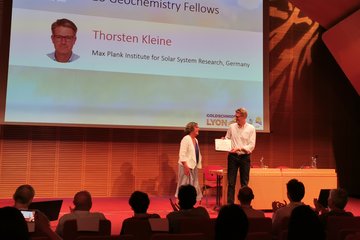Alle Typen
121.
Vortrag
Study of Discrete and Turbulent Cascades in the Outer Magnetosphere: Resonances and Transport. Annual Meeting of the Asia Oceania Geosciences Society , Sapporo, Japan (2014)
122.
Poster
Processes in the dipolarizing flux bundles region: from turbulence to dispersion relation. 29th Cluster workshop, Lanzarote, Canary Islands, Spain (2019)
123.
Poster
Calibration of RAPID/IES 3D electron data: detector-to-detector corrections and long-term degradation. 29th Cluster workshop, Lanzarote, Canary Islands, Spain (2019)
124.
Poster
Forecasting the magnetospheric plasma conditions using Machine Learning Techniques and Cluster RAPID data. Machine Learning in Heliophysics, Amsterdam, Netherlands (2019)
125.
Poster
Prediction of soft protons in the near-Earth space using machine learning. Machine Learning in Heliophysics, Amsterdam, Netherlands (2019)
126.
Poster
Dynamics of ionospheric electrons during St. Patrick's Day magnetic storm in the context of space weather. 4th SPP colloquium “Dynamic Earth”, Bad Aibling, Germany (2019)
127.
Poster
Acceleration of ions in Jovian plasmoids: does turbulence play a role? EGU General Assembly, Vienna, Austria (2019)
128.
Poster
Estimating the Kinetic Energy Budget of the Polar Wind Outflow. EGU General Assembly, Vienna, Austria (2019)
129.
Poster
Acceleration of plasma in current sheet during substorm dipolarizations in the Earth’s magnetotail: comparison of different mechanisms. EGU General Assembly, Vienna, Austria (2019)
130.
Poster
Characterization of turbulent plasma fluctuations inside dipolarizing flux bundles in the Earth’s magnetotail. EGU General Assembly, Vienna, Austria (2019)
131.
Poster
Electron Intensity Measurements by Cluster Mission in Radiation Belts of the Earth. EGU General Assembly, Vienna, Austria (2019)
132.
Poster
Update on the long-term calibration of RAPID/IES 3D electron data. 5th Cluster-Themis Workshop, Chania, Greece (2018)
133.
Poster
Intense current structures observed at electron scales during dipolarization and substorm current wedge formation. European Geosciences Union (EGU) General Assembly 2018, Vienna, Austria (2018)
134.
Poster
Intense current structures observed at electron scales during dipolarization and substorm current wedge formation. COSPAR 2018, Pasadena, CA, USA (2018)
135.
Poster
Turbulent processes in the Earth’s magnetotail: statistical and spectral analysis. European Geosciences Union (EGU) General Assembly 2018, Vienna, Austria (2018)
136.
Poster
Ions in the near-Earth Space. SPP 1788 “SPP Dynamic Earth” Review, Potsdam, Germany (2018)
137.
Poster
Ring current dynamics: why do we need new particle distributions. 3rd Colloquium “SPP Dynamic Earth”, Göttingen, Germany (2018)
138.
Poster
Dynamics of suprathermal electron and proton fluxes during magnetotail dipolarization associated with magnetic flux pile up in the near-Earth plasma sheet. European Geosciences Union (EGU) General Assembly 2018, Vienna, Austria (2018)
139.
Poster
Plasma acceleration on multiscale temporal variations of electric and magnetic fields during substorm dipolarization in the Earth’s magnetotail. European Geosciences Union (EGU) General Assembly 2018, Vienna, Austria (2018)
140.
Poster
Validation of the RAPID/IES 3D electron distributions after correcting for long-term sensitivity decrease. 27th Cluster Workshop, Bled, Slovenia (2017)











